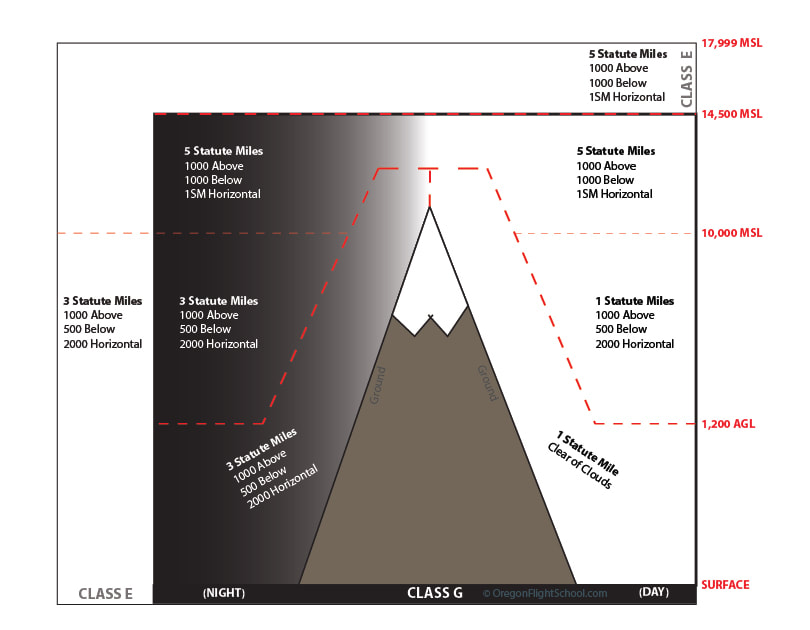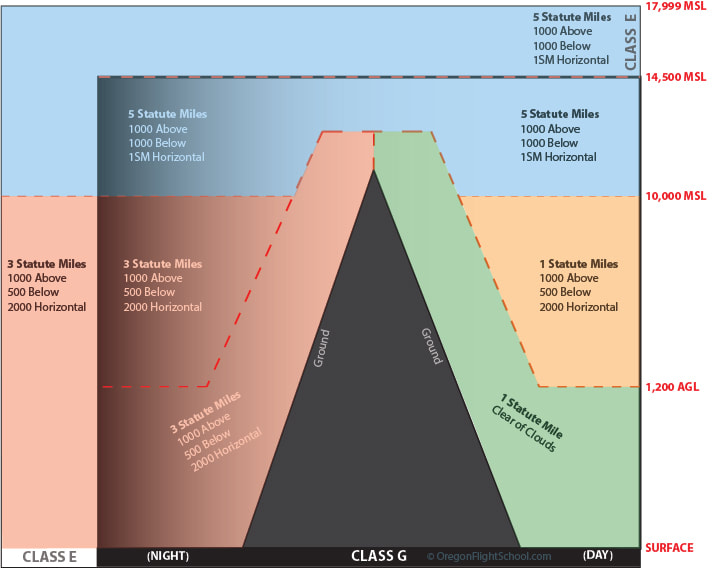|
Memorizing Class G and Class E airspace VFR weather requirements is something that pilots at every certification level struggle with. While you are expected to know them, the reality is that Private, Commercial, and even Airline Transport Pilots often struggle to recall each requirement. The first graphic depicts a night and daytime view of Class G airspace rules, separated by altitude. You are encouraged to print this out and refer to it anytime you are having trouble recalling the rules. The second graphic has been overlaid with colors that group each common weather minimum together. For example, each airspace in the blue segment requires 5 miles vis, 1000a/1000b/1 mile horizontally. When you look at the graphic, you realize that regardless of Class E or G or time of day, this will be your VFR weather minimum above 10,000MSL...unless you are below 1,200 AGL. (If you are like me, and this textual description just made your eyes roll up into your head, just scroll down to *see* what I am talking about) There are a total of only 4 variations in VFR weather requirements, and this graphic simplifies the process of recalling which belong to which. These graphics will be especially helpful to the visual learner who might memorize an image.
Still confused about Airspace? If the subject of airspace is still confusing to you, don't beat yourself up. Airspace is one of the most tricky and nuanced subjects in aviation knowledge. But, it is also critical that all pilots understand airspace well in order to stay safe and avoid any kind of FAA violations, so you may want to invest a little bit in finding a better way to learn it.
Some of us learn best through reading, while others learn best through visual and audio information transfer. If you are one of the latter, you may want to check out this interactive video course on airspace. It contains over 3 hours of video, narration, and animation, and actually explains WHY the airspace exists. Understanding why the airspace exists can often be the "lightbulb" moment for pilots trying to master this area of knowledge. In this course you'll learn everything that you would learn in a traditional airspace course including the following:
1 Comment
|
|
||||||||||||
- Home
-
Flight Instruction
- Private Pilot Flight Training
- Remote Pilot Part 107 Drone UAS Training
- Sport Pilot Flight Training
- Instrument Rating Flight Training
- Commercial Pilot Flight Training
- Multi-Engine Flight Training
- CFI Flight Training
- ATP Flight Training
- Bend Flight Training
- Flight Simulators
- Flight Review
- Paragliding and Paramotoring
- Private Pilot Ground School
-
Courses & Books
- Learning Center
- Contact
- Pilot Resources
- Our Goal
- News
- Ferry Pilot Services
- Contract Pilot Services
- Oregon Flight Instructor Jobs


